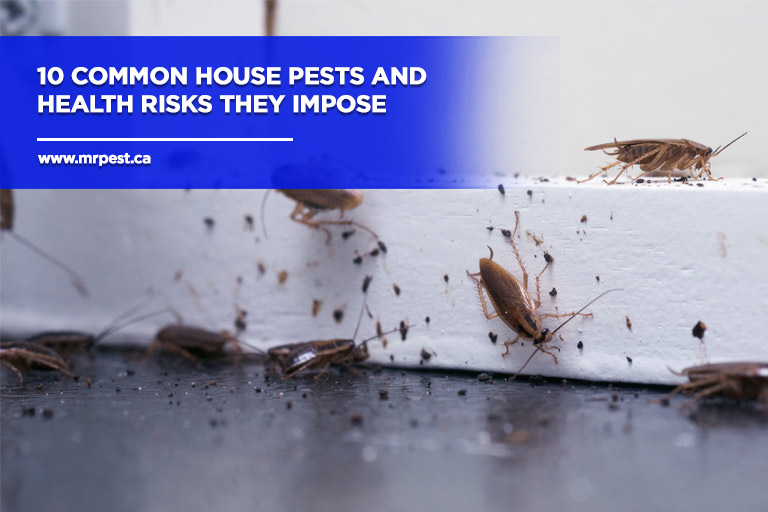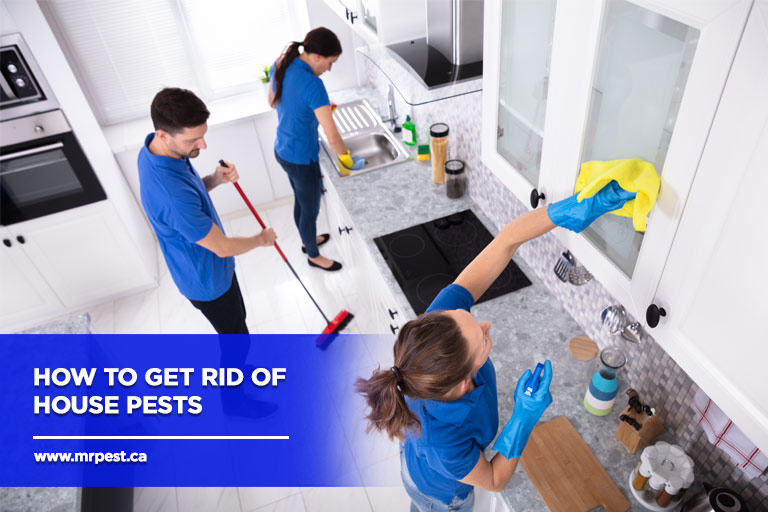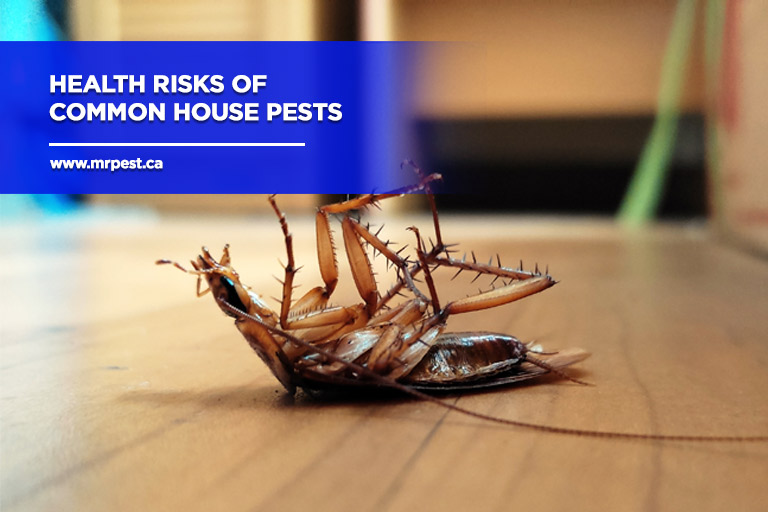Canada is known for its diverse wildlife and natural beauty. However, along with its picturesque landscapes and friendly inhabitants, Canada is also home to a variety of common house pests. These unwanted visitors can disrupt the peace of your home and pose potential health and property risks.
It is essential to shed light on the hidden hazards that common house pests bring to empower you to take proactive measures and create a safe and secure environment. Here is a list of the most common house pests and the risks they pose to you and your family.
10 Common House Pests and Health Risks They Impose

1. Ants
Several ant species, such as carpenter ants, pavement ants, and odorous house ants, are frequently found indoors. They are attracted to food and moisture and can form colonies within the walls.
Health Risk:
While most ants are not direct carriers of diseases, they can contaminate food and surfaces when they come into contact with them. Additionally, some people may have allergic reactions to ant bites or stings.
2. Bed Bugs
Bed bugs are small insects that feed on human blood and are notorious for infesting homes and hotels. They are excellent hitchhikers and can quickly spread from one location to another.
Health Risk:
Bed bug bites can cause itching, skin irritation, and allergic reactions in some individuals. Though they are not known to transmit diseases, their presence can lead to anxiety, sleep disturbances, and psychological distress.
3. Cockroaches
German cockroaches are the most common species found in Canadian homes. They are nocturnal and often infest kitchens and bathrooms, seeking warmth and food sources.
Health Risk:
Cockroaches are known to trigger allergies and asthma attacks, particularly in sensitive individuals. They can carry pathogens like bacteria, viruses, and parasites, which can contaminate food and surfaces.
4. Mice and rats
House mice and Norway rats are common rodent pests in Canada. They can enter homes through small openings and cause damage to property while spreading diseases.
Health Risk:
These rodents can carry and transmit a range of diseases, including hantavirus, salmonellosis, and leptospirosis. They can also introduce parasites like fleas, ticks, and mites into the home.
5. Wasps and hornets
Various species of wasps and hornets, such as yellow jackets and paper wasps, can build nests in and around homes. Their stings can be painful and may cause allergic reactions in some individuals.
Health Risk:
Wasp and hornet stings can cause severe allergic reactions in some individuals, which may require immediate medical attention.
6. Flies
Common house flies and fruit flies are often found indoors, especially during warmer months.
Health Risk:
Flies can carry pathogens and contaminate food, contributing to the spread of diseases like diarrhea, food poisoning, and dysentery. They can pick up bacteria and viruses from waste materials and then transfer them to exposed surfaces and food items.
7. Silverfish
These small, wingless insects prefer dark and damp areas like basements and bathrooms. They feed on starchy substances, such as glue and paper, and can damage books, wallpaper, and clothing.
Health Risk:
While silverfish are not known to transmit diseases, they can damage books, paper, clothing, and other household items, leading to economic loss.
8. Spiders
While most spiders found in Canadian homes are harmless, some people may have a fear of them. Black widows and brown recluses are uncommon but are dangerous species.
Health Risk:
Most spiders found in Canadian homes are harmless, but certain species like black widows and brown recluses have venomous bites that can cause severe reactions and may require medical attention.
9. Carpet beetles
Carpet beetles can infest carpets, clothing, and stored food items. Their larvae can cause damage to fabrics, fur, and other organic materials.
Health Risk:
Carpet beetle larvae can cause skin irritation and allergic reactions in some individuals. They can also damage fabrics, carpets, and stored food items.
10. Squirrels
Although not strictly house pests, squirrels can sometimes find their way into attics and cause damage. They are skilled climbers and can chew through materials to gain entry.
Health Risk:
Squirrels themselves are not major carriers of diseases, but their feces and urine can contaminate the environment, potentially spreading diseases indirectly. Additionally, their gnawing behaviour can cause structural damage and fire hazards if they chew on electrical wiring.
To minimize health risks associated with pests, it’s important to maintain a clean and hygienic living environment, practice proper food storage and waste management, and seal entry points.
It’s important to note that pest prevalence and types can vary by region and climate within Canada. If you suspect a pest infestation in your home, it’s advisable to consult with a pest control service provider or your local pest control professionals for accurate identification and effective treatment.
How to Get Rid of House Pests

Having common house pests can be a frustrating and unpleasant experience. These unwelcome guests can include ants, cockroaches, spiders, flies, and mice. However, fret not! With a proactive approach and a few effective techniques, you can reclaim your home and bid farewell to these pesky intruders. Here are some practical and eco-friendly solutions to help you get rid of common house pests.
- Seal Entry Points
The first step in pest control is preventing their entry into your home. Inspect your property for any cracks, gaps, or openings in windows, doors, and walls. Seal them with caulk or weatherstripping to block their access points. Remember to pay extra attention to utility lines and pipes that enter your house, as these are common entry points for pests.
- Maintain Cleanliness
Pests are attracted to food and water sources, so maintaining a clean home is crucial. Wipe down countertops, clean up spills promptly, and store food in airtight containers. Regularly vacuum and sweep floors, paying close attention to corners and hard-to-reach areas. Dispose of garbage in tightly sealed bins, and keep outdoor trash areas clean to avoid attracting pests.
- Eliminate Standing Water
Many pests thrive in damp environments. Check your home for any areas of standing water, such as leaky pipes, clogged gutters, or birdbaths. Fix leaks promptly, ensure proper drainage, and remove any stagnant water sources to discourage pests like mosquitoes and ants.
- Natural Repellents
Instead of using harmful chemicals, consider using natural repellents to deter pests. Ants dislike strong scents like peppermint, lemon, or vinegar. Spraying a solution of these scents near entry points can discourage ants from invading your home. Essential oils like lavender or eucalyptus can help repel flies and spiders. Experiment with natural remedies to find what works best for the pests in your home.
- Traps and Baits
For persistent pests like cockroaches or mice, traps and baits can be effective. Place sticky traps or bait stations in areas where these pests are commonly seen. Ensure that traps are safely out of reach of children and pets. Monitor the traps regularly and dispose of captured pests promptly.
- Professional Assistance
If your pest problem persists despite your efforts, consider seeking professional assistance. Pest control experts have specialized knowledge and experience to effectively handle infestations. They can identify the source of the problem and provide targeted solutions to eradicate pests from your home.
By adopting these simple yet powerful techniques, you can take control of your home and bid farewell to common house pests. Remember, prevention is key, so maintaining cleanliness, sealing entry points, and eliminating favourable conditions for pests are essential steps. Embrace natural repellents, traps, and baits as your allies in the battle against pests. And when needed, don’t hesitate to seek the help of professional pest control services.
Protect your home from pests and the hazards they bring; contact Mr. Pest Control. Send an email to peteb@mrpest.ca and rest assured that everything is taken care of. By taking swift action and maintaining your property, you can ensure a pest-free home.



